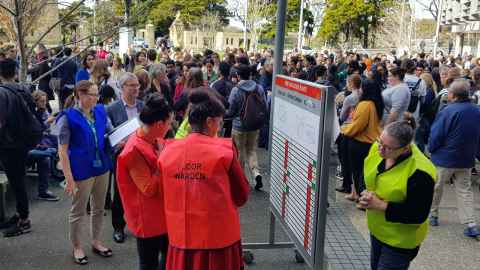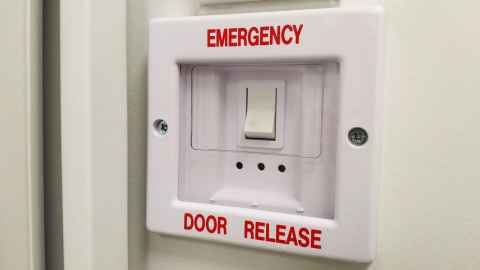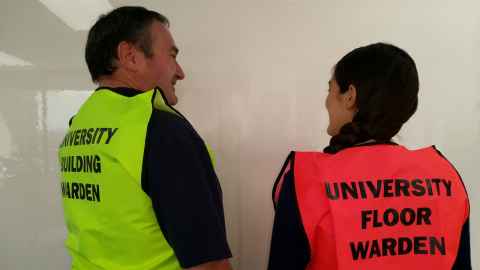Evacuation
In most emergency situations, you need to get out of a building and to a safe assembly point.

If the fire alarm sounds:
- Stop what you are doing. Alert those around you (especially those wearing headphones)
- Shut down machinery/equipment if safe to do so
- Evacuate the building. Report to the safe evacuation area
- Do not run. If you are slow due to injury etc., let other people evacuate first
- Do not use lifts
- Do not carry bulky items. You may take keys, money and other small items close to hand that you might need if re-entry is not possible. DO NOT stop to search for items or return to collect them - evacuate IMMEDIATELY!
- Help people who need assistance. More information: People requiring assistance
- Do not re-enter any building until given the all-clear by the Fire Service or building warden. (Floor wardens may help spread the message, including any conditions for re-entry).
Is there an emergency but no alarm is ringing?
If you become aware of an emergency that requires a building evacuation.
- Alert people near you
- Activate the nearest alarm
- Contact emergency services
- Contact University Security
- If possible, notify the floor warden and/or building warden.
Staff duties in an evacuation
When the alarm sounds
- Ensure that students and other visitors evacuate the building by the nearest exit.
- Lecturers: You are responsible for ensuring that people in your classes safely evacuate the building.
- Wardens: You have an important role in an evacuation.
Find out more: Area and Building Wardens.
Someone refusing to leave the building?
Don't waste time arguing. Note their name or room number and report them to the building warden.
Not responsible for any students/visitors and not a warden?
Help wherever possible to ensure your building is evacuated effectively.
Do you work in an area that wardens can't search?
If you're maintenance staff and work in plant rooms or other areas that wardens can't search, evacuate when the alarm sounds and report to the building warden that the area is clear of occupants.
Important: Do you need evacuation assistance?
Organise an evacuation plan before an emergency.
Find out more: People requiring assistance
Before an evacuation
Staff responsibilities before an evacuation
All staff
- You must be able to open all fire exit doors without keys
- Exit paths must be kept clear
- Smoke-stop doors should never be wedged open. If you see one open, please report it to the building warden or a senior staff member immediately
- Read fire action notices and become familiar with what you need to do
Academic staff
- Ensure that students know where to find exits and assembly points for the lecture facilities.
- Do this at your first lecture for each group of students at the start of every semester (or every course if it does not involve a full semester).
Are you responsible for a building?
Ensure that:
- Users know about the building's evacuation procedure
- You have a sufficient number of area and building wardens available at all times the building is operational
Fire action notices
Fire action notices are displayed throughout the University. They provide information on actions to take in the event of a fire where to go in an emergency. Be familiar with these before an emergency.
Assembly points
Each University building has recommended assembly points. These may change depending on wind direction or the nature of the emergency. However, the important thing is to get well clear of any hazards.
You should be made aware of the assembly points as part of any induction or safety briefing at your faculty.
The information is also displayed on the fire action notices throughout University buildings. Additionally, some faculties or service divisions have this information on their intranet. For more information, contact your line manager or academic leader.
Exit door not opening?
Be aware that most doors are released when the alarm sounds. Important note: Most card readers will remain red but the doors should unlock. If the doors are still locked, then:
- Look for the emergency door release.
- Press or break the cover. Depress the release switch. This will release the door.

Re-entry information
- Only re-enter a building when the fire service or building wardens instruct you that it is safe to do so. Do not re-enter when the alarm stops ringing.
- Re-enter in stages where possible. Allow staff and those with mobility impairments in first, then upper floor occupants.
- Encourage occupants on lower floors to use the stairs, rather than overwhelming lifts and lobby areas.
Building Systems
- May remain offline temporarily, e.g. lifts, ventilation systems, security doors, until the building's fire safety system has been reset. This can be dependent on the building's age and the type of system installed.
Important phone numbers
Fire service
Phone: 111 (1-111 internal)
Security
Phone: 966 (internal) or 0800 373 7550
- Know your street address and building number

Document Control
Version: 1.1
Last Updated: March 2024
Next Review: March 2027
Owner: hsw@auckland.ac.nz
Approver: Associate Director, Health Safety & Wellbeing